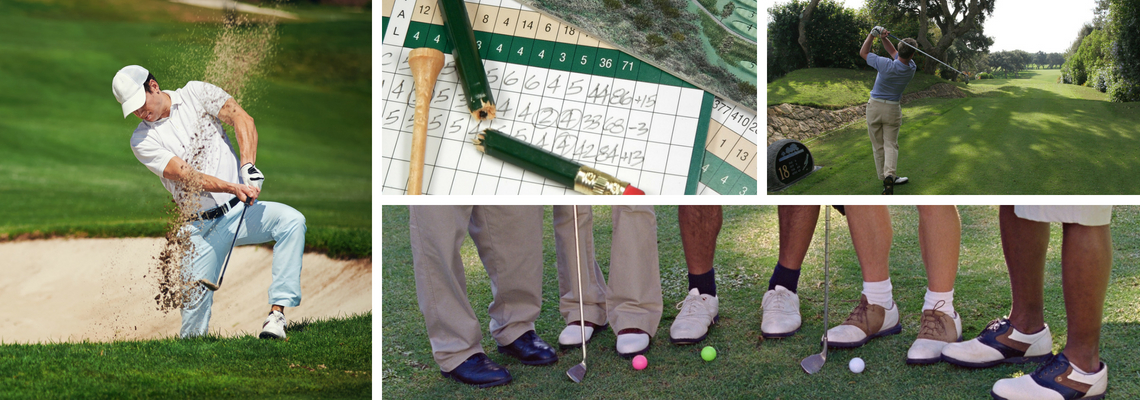Hitting over a hazard…
Standing on the tee looking down a tight fairway…
Having the group behind hovering as you hit your next shot…
Facing a short putt to avoid a big number on a hole…
What scenarios cause your adrenalin to start pumping?

Golf fear — Is it your friend or foe?
If you see it as a foe, I’m here to inform you that it’s the misunderstanding you have with your fear that has transformed it from an ally into a nemesis.
To operate in golf or life without experiencing fear is an unrealistic expectation. Fearlessness means playing without fear. Courage means learning how to operate better because of it.
Your fear response is part of your DNA, therefore it’s not something you can eliminate. That hard wiring is not designed to derail you.
Fear is one of the inner tools in golf that you can use to help you play great. Share on X
There’s a difference between real and imagined fear.
- Real fear prevents you from retrieving a ball from the edge of the water where an alligator is swimming.
- Imagined fear is a “danger” situation that you create in your mind, but that lacks substance to cause you actual harm.
Either way, you must look at fear for its value — fear is simply signaling a lack of information.
If fear is an internal alert designed to get you to take notice of something important, then consider the role fear has been playing in your game.
You’re standing on the tee of a Par 3 that has a carry over water to the green. You’ve selected the appropriate club for the distance to your landing spot on the green, and have taken some nice smooth practice swings. You feel ready to go as you step into the shot. The wind kicks up, and you start to feel uncomfortable now standing over the ball. You waggle an extra time or two, and try to take some deep breaths to calm your nerves and keep the thoughts of your ball taking a swim out your mind. But in the end, you decide to push through because, after all, you can just swing a little bit harder…
Well, you probably know from experience how this shot ended badly. And there was no reason, aside from your stubbornness, to ignore the warning signs. Your fear response kicked in and you made a decision to try to stuff it under the proverbial rug instead of using it to your advantage.
When you recognize that fear (or any of its siblings like worry, discomfort, nerves, or muscle tension) is an opportunity not an obstacle, you actually start saving strokes in golf.
Here’s how.
1. Change your perspective
Before you can begin to use fear as an asset in your game, you need to adjust your perspective of it. We are trained to assess a fear response as a warning of impending danger or failure, or a sign that something is definitely wrong. The problem is that we often view the fear response as a finality, rather than a possibility. The key is that you CAN decide to change course.
The moment you experience fear, you must train yourself to hit the pause button to give yourself the time and space to evaluate your situation and course correct if warranted. If you’re worried about pace of play, keep in mind that you actually save time when you pay attention to your fear, adjust and hit a better shot, than when you proceed and hit a poor shot that adds a stroke or more time hunting for a lost ball.
2. Change your response
Perhaps you’re accustomed to trying to ignore your fear, gut it out, and get the shot over with quickly because it might somehow minimize the damage. This approach will never work well, and has likely caused you more than enough frustration to date.
As I mentioned above, fear is simply lack of information, therefore you need to restart your shot plan to cover all your bases. Did you miscalculate the strength of the wind? Are you still having an inner debate about which club to use? Did you have a poor practice swing and are hoping that you get it right when over the ball? If you’re uncomfortable before or after you address the ball, you have no business proceeding with the shot. Not unless you’re okay with hitting a less than ideal shot. Give yourself the best opportunity to be successful by restarting your shot plan to plug up any questions with solutions so that you can confidently step up to the ball and pull the trigger.
3. Change your results
When you learn how to faithfully adhere to steps one and two above, giving yourself a higher probability of hitting a higher quality shot the first time, every time, you’ll positively impact your score. It’s really that simple.
Golf fear: Discover the 3 steps to transform it from foe to friend in your game. Share on XStop treating fear like the enemy when it was designed to be your friend. Learn to listen and leverage the opportunity your fear response provides and you’ll stop giving strokes away, thus reducing the number of frustrating moments you have to endure in 18 holes.
How has fear been holding you back from playing your best?
If you’ve got a struggle with golf fear and need some help, please leave me a comment below and I will be happy to assist you with it.
Leave a Reply